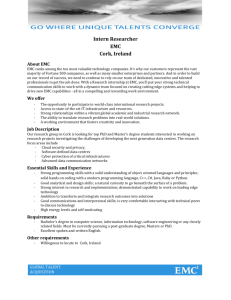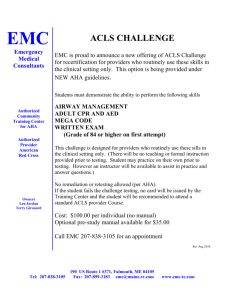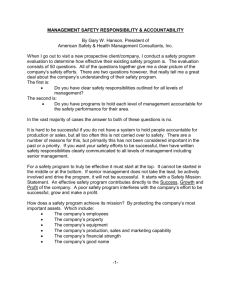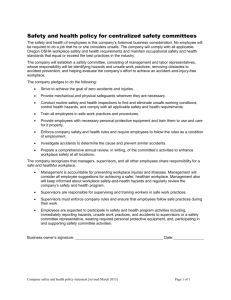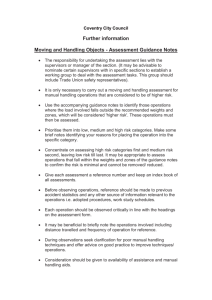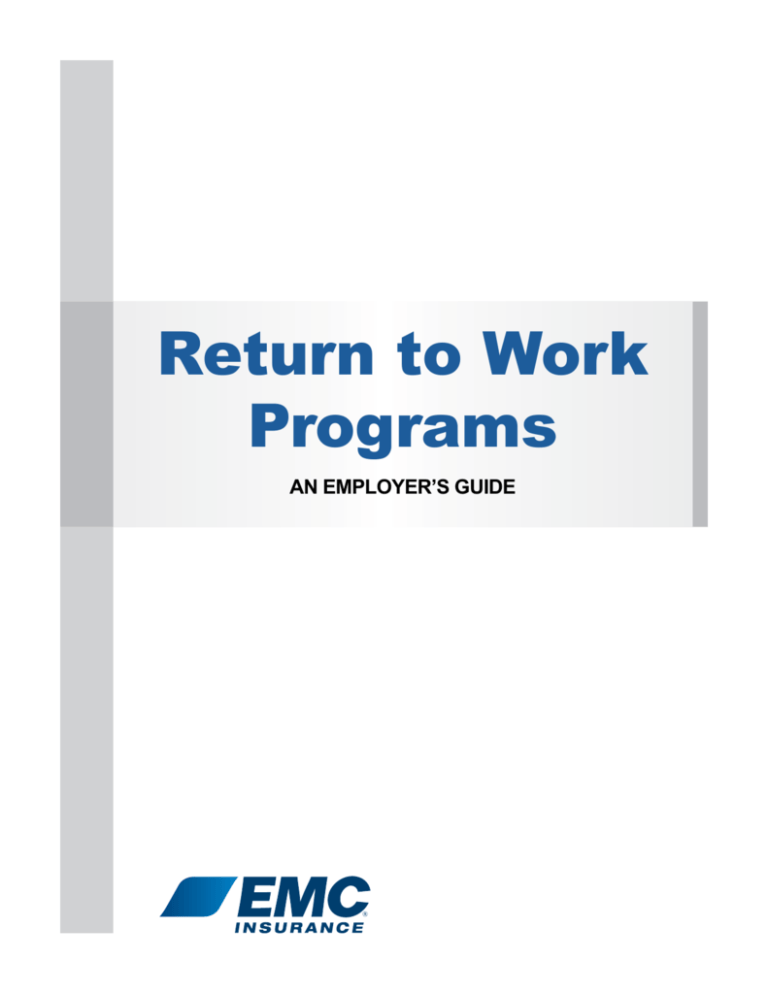
Return to Work
Programs
AN EMPLOYER’S GUIDE
Next to accident prevention, an early return to work program is one of the best management tools
a business can implement to control workers’ compensation costs and reduce losses.
A return to work program is an organized system designed to bring injured or disabled employees safely back
into the work environment as soon as they are medically capable. Transitional work duties are matched to an injured
worker’s abilities for a specific time frame, allowing them to rejoin the workplace earlier and helping to reduce
your costs.
Benefits of a timely and medically-approved return to work program can include:
• Reduced workers’ compensation premium and experience modification factor
• Reduced operations costs, such as overtime pay, retraining, rehiring, loss of production while the position
is not filled
• Reduced indemnity payments as the employee is back at work earning at least part of their wages
• Improved communication between employer and employee
Effective return to work programs have been shown to reduce the chance that an employee will become totally
and permanently disabled. A program can also give your organization more control and reduce overall medical
costs because injured employees are seen regularly by their physicians and monitored on the job. EMC can help
organizations of all sizes and types
to develop a return to work program.
A successful return to work program benefits both the employer and the employee. Count on EMC® to help
get you started.
For more information on return to work programs and other loss control services, contact your independent
insurance agent or access EMC’s Risk Improvement Department by phone at (515) 345-2520 or email
at losscontrol@emcins.com.
Common Questions About Early Return to Work Programs
What is a return to work program?
A return to work program is designed to provide appropriate work for employees who are injured or ill.
The employee’s participation continues until he/she has fully recovered.
Who is it for?
A return to work is ideal for employees unable to perform their normal and customary job functions due
to illness or injury.
How does it work?
A return to work program establishes tasks that are medically approved, temporary and transitional for assignment
during a worker’s recovery period.
What key points do I need to know about return to work programs?
• A return to work program should be set up before it is needed.
• Written policies and procedures should be formalized and presented to the workplace.
• Detailed functional job descriptions are necessary for return to work determinations.
• Training of employees and supervisors is crucial—supervisors MUST support the program.
• Transitional work assignments are based on a functional match between job demands and the worker’s current
abilities and restrictions.
• Transitional work assignment may change several times during the worker’s medical recovery.
• Return to work guidelines can be applied to both workers’ compensation cases and general health situations,
including off-the-job injuries.
• Work tasks must be meaningful, not busy work.
• A return to work program is an interim step in the employee’s medical recovery process.
What are the goals of a return to work program?
• Return the employee to full duty as soon as medically possible.
• Promote healing by involving the employee in work projects, keeping him/her active in a
medically-approved way.
• Keeps employees “in touch” with their jobs, coworkers and workplace management.
• Save money towards future insurance costs.
Why is a return to work program a mutual benefit for both employer and employee?
• The employer minimizes costs while retaining the use of a trained employee.
• The employee comes back to work and avoids loss of wages and a long-term absence.
What kind of results can an effective return to work program produce?
• Increased productivity—injured workers remain on the job instead of being at home.
• Increased worker morale—employees feel productive and valued by the employer.
• Potential savings—a reduced experience modification factor may reduce insurance premiums.
Six Steps for Implementing a Return to Work Program
STEP ONE: Analyze Positions and Complete Written Job Descriptions
• Conduct a functional job analysis for all regular positions. Create written job descriptions for each position,
identifying the essential job functions.
• Review injury data from the past one to two years, such as your injury records or EMC’s claims records, to identify
problem jobs that should be addressed first by your return to work efforts. Look for jobs affected by lost-time
injuries, such as musculoskeletal injuries, multiple injuries and trauma, and jobs where task activities include lifting,
balancing, use of ladders, overhead lifting and reaching, repetitive motion and postures, awkward postures or
climbing.
• Construct an organization-wide return to work program policy statement.
• Include employees and supervisors in the functional job analysis process to achieve consensus and validation of
job descriptions.
Question: Who completes this step?
Answer: The employer completes this step with help from
EMC loss control and claims representatives.
STEP TWO: Identify Transitional Jobs With Accompanying Job Descriptions
• Identify and document some predetermined modified tasks that meet typical medical restrictions, such as lifting,
walking, standing, overhead reaching, one-handed duties, bending and sitting. It’s important to identify these tasks
and job descriptions before they are needed.
• Don’t forget to consider seasonal tasks, “rainy day” projects and other meaningful tasks that need to be done (such
as inventory or data logs).
Question: Who identifies transitional jobs?
Answer: Supervisors and management staff identify these
transitional jobs, with help from EMC.
STEP THREE: Identify Medical Providers
• Interview local occupational health physicians and physical therapy staff to determine whether or not they are able
to meet the informational needs of your company. Talk with your insurance adjuster to help ensure these services
are compatible with claims handling procedures.
• Share your written essential functional job descriptions with your selected medical providers and offer tours of your
facilities.
Question: Who selects appropriate medical
providers?
Answer: The employer selects medical providers, with
assistance from EMC.
STEP FOUR: Appoint a Coordinator
• Designate an in-house workers’ compensation coordinator and set up return to work reporting formats, letters
and other documentation.
• A variety of staff may be appropriate for this position—common designees include occupational health nurses,
human resource representatives or safety managers.
• The coordinator must be readily accessible to injured workers, supervisors, the claims adjuster and medical
providers so communications are effective and timely.
Question: Who selects this coordinator?
Answer: Upper management chooses the
in-house coordinator.
STEP FIVE: Train Supervisors and Employees
• All supervisors and employees must understand what to do when an injury occurs and what step-by-step
processes they should follow.
• Training should include receipt of your written return to work policy and details on when it will become effective.
• Instruct supervisors on the importance of their roles in the return to work process and how to avoid overstepping
their boundaries as supervisors.
• Get employee buy-in to the return to work program by broadcasting the program benefits, the medical providers
involved and reporting responsibilities of all parties.
• Make the essential functional job descriptions of both regular and alternative duty assignments available
to employees.
• Encourage cooperation and communication.
• Communicate with your EMC claims and loss control team when questions arise.
• Set up regular claims conferences with your EMC claims representatives.
Question: Who provides the training and coordinates
communications?
Answer: Training and communications are provided by
your in-house coordinator, the EMC claims adjuster and
EMC loss control representatives.
STEP SIX: Review and Adjust Program Components
• Regularly review and update functional job descriptions.
• Regularly communicate return to work and safety results to all employees.
• Survey supervisors, workers and medical providers about the ease of forms and other communications.
• Brainstorm improvements with your in-house coordinator, supervisors, employees and upper management.
Question: Who follows up on this ongoing task and
determines success?
Answer: This ongoing task is shared by upper
management, supervisors, the in-house coordinator
and EMC staff.
Return to Work Program Assistance from EMC
We can help you:
• Review a two- to four-year history of injury/illness in the workplace to identify types of injury.
• Note if particular jobs or functions contribute to the pattern. This has the added benefit of helping you identify areas
that should be examined for permanent modifications or added safety features.
• Create a well-defined corporate policy about use of return to work programs to establish a sense of value among
employees and supervisors.
• Complete functional job analysis of regular job positions, starting with the most problematic.
• Identify transitional duty areas and tasks by analyzing job descriptions, and identify modifications for common
injuries and restrictions.
• Identify occupational medicine clinics that handle workers’ compensation injuries. With our Select Provider
program, we can also interview clinic staff and doctors to set up an account.
• Share job descriptions with treating physicians and offer tours of your facility.
• Create reporting and other written formats for supervisors and employees.
• Train employees and supervisors on what to do when an injury occurs.
• Provide guidance for the appointment of an in-house workers’ compensation coordinator.
• Help you understand your state’s workers’ compensation laws and first report responsibilities.
• Set up regular claims conferences with your adjuster.
• Modify job descriptions as needed.
• Regularly communicate return to work and safety results to employees.
Injury Management
Injury management focuses on hiring people fit for the job and keeping them safe and healthy while at work, but
if they do get hurt, injury management can also provide the best care for injured workers and returns them to work as
quickly as possible. An integrated approach to injury management can help you minimize the number, severity and
cost of these injuries, and at the same time help your productivity and control workers’ compensation insurance costs.
Key Pieces of the Injury Management Puzzle
Select Provider Program
Return to Work Program
• Arranges quality medical care for
employees from providers with
experience treating workplace injuries
• Helps control workers’ compensation premiums
and experience modification factors
• Improves communications with injured
employees, reducing the frequency of
attorney involvement
• Helps employers organize their initial
response to a workplace injury or illness
• Informs those involved in workers’
compensation claims of their
roles and responsibilities
• Brings injured workers back
safely and sooner
Safety
• Helps identify and control the risk of injury
• Investigates accidents to determine root causes
• Helps prevent accidents from occurring
Hiring Practices
• Uses prework screenings to
hire workers who are physically
capable of doing the job
Health and Wellness
• Creates functional job descriptions
to reduce workplace injuries
• Reduces absenteeism and injuries
• Increases productivity
• Uses background checks and drug testing
to eliminate potential sources of
Now
workplace problems
• Decreases risk factors for chronic disease,
which may result in lower health care and
workers’ compensation expenses
Hiring
Hello
Contact EMC Today
EMC loss control representatives are ready to help you take advantage of a comprehensive injury management program.
To get started, contact your independent insurance agent or send an email to losscontrol.injurymgmt@emcins.com.
©Copyright 2014 Employers Mutual Casualty Company. RI0018
www.emcins.com |
For more information, contact
the Home Office Risk Improvement Department:
EMC Insurance Companies
717 Mulberry
Des Moines, IA 50309
losscontrol@emcins.com
www.emcins.com
Disclaimer: This material is designed and intended for general information purposes
only, and is not intended, nor shall be construed or relied upon, as specific legal advice.
©Copyright Employers Mutual Casualty Company 2014. All rights reserved. 9125 (7-14)

